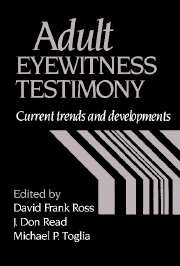Book contents
- Frontmatter
- Contents
- List of contributors
- Preface
- Part I Cognitive, physical and social processes and factors influencing eyewitness recall and identification
- Part II Lineup construction and collection of testimony
- Part III Whom to believe? Distinguishing accurate from inaccurate eyewitnesses
- 13 Distinguishing accurate from inaccurate eyewitness identifications: A reality monitoring approach
- 14 Decision times and eyewitness identification accuracy in simultaneous and sequential lineups
- 15 Individual differences in personality and eyewitness identification
- 16 Eyewitness identification confidence
- 17 Expectations of eyewitness performance: Jurors' verdicts do not follow from their beliefs
- 18 The appraisal of eyewitness testimony
- Name index
- Subject index
14 - Decision times and eyewitness identification accuracy in simultaneous and sequential lineups
Published online by Cambridge University Press: 04 August 2010
- Frontmatter
- Contents
- List of contributors
- Preface
- Part I Cognitive, physical and social processes and factors influencing eyewitness recall and identification
- Part II Lineup construction and collection of testimony
- Part III Whom to believe? Distinguishing accurate from inaccurate eyewitnesses
- 13 Distinguishing accurate from inaccurate eyewitness identifications: A reality monitoring approach
- 14 Decision times and eyewitness identification accuracy in simultaneous and sequential lineups
- 15 Individual differences in personality and eyewitness identification
- 16 Eyewitness identification confidence
- 17 Expectations of eyewitness performance: Jurors' verdicts do not follow from their beliefs
- 18 The appraisal of eyewitness testimony
- Name index
- Subject index
Summary
Learning from common sense psychological assumptions in the history of legal decision making
For a long time legal scholars have recognized that mistaken identifications have been and continue to be a major source of miscarriages of justice (for example, Sello, 1911; Hirschberg, 1960; Peters, 1972; Sobel, 1983; see Lipton, in press, for a recent review of the legal literature on this topic). Considering the fact that problems with identification seem to have been realized time and again, the judiciary should be equipped to meet this problem, and the occasional reoccurrence of false identifications should not be that surprising or unusual. The crucial issue seems to be, however, that triers of fact do not notice or know how to tell when an identification attempt is in error. The question we have to address is why identification decisions are so difficult to evaluate and what means might be available to improve assessment of identification decisions in individual cases.
The particular problem with identification evidence has been pointed out by the judiciary and psychological researchers alike. As Lord Devlin has phrased it most succinctly:
[T]he problem peculiar to evidence of visual identification is that this evidence, because of its type and not because of its quality, has a latent defect that may not be detected by the usual tests. The highly reputable, absolutely sincere, perfectly coherent, and apparently convincing witness may, as experience has quite often shown be mistaken. (Devlin, 1976, cited in Shepherd, Ellis, & Davies, 1982, p. v).
- Type
- Chapter
- Information
- Adult Eyewitness TestimonyCurrent Trends and Developments, pp. 300 - 327Publisher: Cambridge University PressPrint publication year: 1994
- 35
- Cited by



